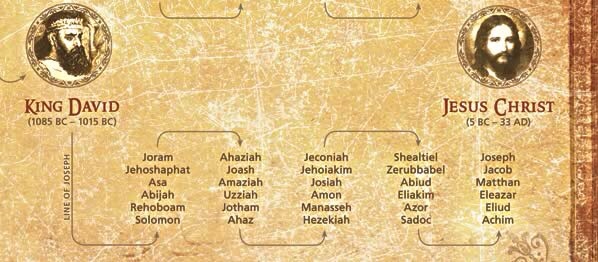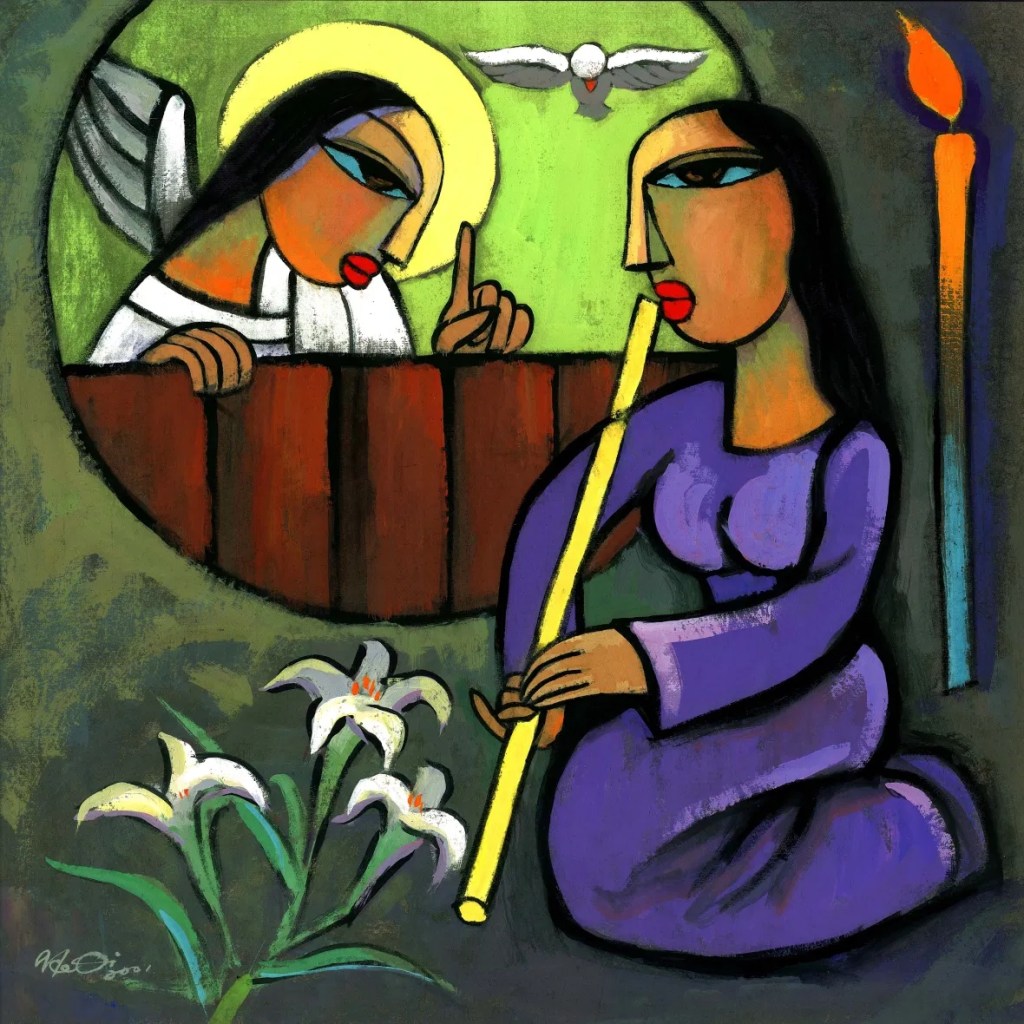The orderly account of the things coming to fulfilment (which we know as the Gospel of Luke) tells us much more about the beginnings of Jesus (his conception, birth, and early days) than the other Gospels. The passage offered by the lectionary for this Sunday is one such text.

It’s a well-known and familiar passage, from the very beginning of the Christmas story (Luke 1:26-38). It is the scene that is often called The Annunciation. The announcement that is being made in this scene, is to Mary, informing her that she will bear a child.
Mary responds dramatically to this news. She is perplexed, amazed; she is a virgin. “How can this be?”, she asks. A messenger from God informs her, though, that impossibilities are now becoming realities. Indeed, her aged, barren cousin is now pregnant, and Mary will find herself bearing a child—but no ordinary a child; a child “who will be holy, who will he called Son of God”. Now that is really out of the ordinary!
We learn all of this through the “reporting” of a dialogue between the two characters, mother-to-be Mary, and the angel Gabriel. The dialogue isn’t an actual transcript of what took place—indeed, there is no way that the author of this Gospel could have been present to listen and remember.
Instead, the scene is based on the typical dialogue scene that we find at many places in Hebrew Scriptures. And it comes hard on the heels of a similar encounter, another dialogue scene, reported earlier in this chapter (Luke 1:5-22). The earlier dialogue involved an older man, Zechariah (although this dialogue ends up with Zechariah being completely mute); the next scene involves a young woman (who holds her own in the dialogue, as we shall see).
The dialogue proceeds, just as we would expect: he said, then she said; then he said, and so she said. He, of course, is the angel Gabriel. She is Mary, at this time identified simply as “a virgin engaged to a man whose name was Joseph” (1:27).
Jews knew about the angel Gabriel from his appearances to Daniel (Dan 8:15-17, 9:21). He appeared to Daniel at the time of prayer (Dan 9:21)—presumably this is the same angel who had earlier appeared to Zechariah, in Jerusalem, at a time of prayer (1:10-11).

If this is indeed the same angelic person who appeared to Daniel (and to Zechariah, and Mary), then he was quite a sight; Daniel describes Gabriel as “a man clothed in linen, with a belt of gold from Uphaz around his waist. His body was like beryl, his face like lightning, his eyes like flaming torches, his arms and legs like the gleam of burnished bronze, and the sound of his words like the roar of a multitude.” (Dan 10:5-6).
Such an appearance would undoubtedly evoke fear. Indeed, before Gabriel even speaks to him, Zechariah is said to have been “terrified, and fear overwhelmed him” (Luke 1:12), as also was Daniel (Dan 8:17), who says that “my strength left me, and my complexion grew deathly pale, and I retained no strength”, before he fell in a trance to the ground (Dan 10:8-9).
So the words of the angel, in both scenes, seek to meet this understandable response. “Do not be afraid”, he says to Zechariah (1:13) and also to Mary (1:30). This is what angels do; this is how they greet people: “do not be afraid” (see Gen 15:1, 26:24; 2 Kings 1:15; Dan 10:9). Zechariah’s fear had gripped him before he spoke a word, but Mary had the presence of mind, before the angel spoke these words, to reflect on what she was experiencing.

The dialogue begins when Gabriel greets Mary (1:28) and informs her that she was favoured (the word comes from the Greek word charis, which means grace or favour, and becomes a key theological term in early Christianity). Mary is described as being “much perplexed by his words and pondered what sort of greeting this might be” (1:29).
He then says, as we have noted, “Do not be afraid, Mary, for you have found favour with God.” That is followed by a declaration of the name of the child: “you will conceive in your womb and bear a son, and you will name him Jesus” (1:31). This is parallel to the declaration made to Zechariah: “your prayer has been heard; your wife Elizabeth will bear you a son, and you will name him John” (1:13).
This follows the same pattern in scriptural stories when divinely-favoured women are told they will give birth, and they name of their child: Hagar, mother of Ishmael (Gen 16:11), Sarah, mother of Isaac (Gen 17:19), Gomer, the wife of Hosea and mother of three children (Hosea 1:4,6,9); and see also the moment of naming for Leah, mother of Asher (Gen 30:13), the unnamed mother of Samson (Judges 13:24), and Hannah, mother of Samuel (1 Sam 1:20).
The angel continues: “He will be great, and will be called the Son of the Most High, and the Lord God will give to him the throne of his ancestor David; he will reign over the house of Jacob forever, and of his kingdom there will be no end” (1:32-33). The Davidic ancestry of Jesus was an important claim for the early Christians. It was cited in early literature as a key element (Luke 2:4; John 7:42; Rom 1:3; 2 Tim 2:8; Rev 5:5, 22:16; see more on this at https://johntsquires.com/2019/12/19/descended-from-david-according-to-the-flesh-rom-1/).

Mary still is not fazed. She comes right back at the angel: “How can this be, since I am a virgin?” (1:34). Good point, well made! Only once, here in Luke, and only once in Matthew’s account, is the point made that Mary was a virgin when she conceived (Matt 1:23; see my consideration of this issue at https://johntsquires.com/2019/12/21/a-young-woman-a-virgin-pregnant-about-to-give-birth-isa-714-in-matt-123/)
In response to this good comeback, Gabriel responds with a number of significant points. First, “The Holy Spirit will come upon you, and the power of the Most High will overshadow you; therefore the child to be born will be holy; he will be called Son of God.” This statement references three central scriptural elements.
The Holy Spirit is understood to be active throughout the story of Israel: at the moment of creation (Gen 1:1-2), bringing all creatures into being (Ps 104:30), in equipping specific leaders (Exod 31:2-3; Num 11:25, 26; Deut 34:9; Judges 3:9-10, 6:34, 11:29, 13:25; 1 Sam 10:6, 10, 11:6, 16:13, 2 Sam 23:2; 2 Kings 2:9, 15), by inspiring the prophets (Isa 61:1: Ezekiel 2:2; Joel 2:28-29), and in the servant of the Lord (Isa 42:1). Mary here stands with others early in Luke’s story who experience the Holy Spirit coming upon them (John, 1:15; Elizabeth, 1:41; Zechariah, 1:67; Simeon, 2:25-26); and, of course, Jesus himself is filled with the Spirit (3:22; 4:1).
Holiness was a central element of piety in ancient Israel; the holy God called a holy people to live in covenant with him, and exhibit holiness in every aspect of life (Lev 11:44-45, 19:2, 20:7-8; Exod 19:6; Deut 7:6, 14:2, 21, 28:9). Following from this prophetic word to his pregnant mother, the adult Jesus was indeed known as “the holy one” (Mark 1:24; Luke 4:34; John 6:69; Acts 3:14, 13:35).
“Son of God” was also a phrase derived from older traditions; the king was regarded as God’s son (Ps 2:7; 2 Sam 7:14), commencing with David (Ps 89:26-28), and Israel as a whole was regarded as God’s son (Exod 4:22: Jer 31:9, 20). It is applied to Jesus with regularity in his adult life (Luke 4:3,9,41; 8:28; 22:70; Acts 9:20; John 1:34,49; 11:4,27; 19:7; 20:31) as well as in early confessions of faith (Rom 1:4; 2 Cor 1:19; Gal 2:20; Eph 4:13; Heb 4:14; 6:6; 10:29; 1 John 3:8; 4:15; 5:5; Rev 2:18).
Then, Gabriel tells Mary, “your relative Elizabeth in her old age has also conceived a son; and this is the sixth month for her who was said to be barren” (1:35). The Hebrew Scriptures offer accounts of women thought unable to bear a child, being visited by an angel and gifted a child by God, such as Sarah (Gen 11:30), Rebekah (Gen 25:21), and the woman who bore Samson (Judges 13:3). This blessing from God is celebrated by the psalmist (Ps 113:9) and the prophet (Isa 54:1).

Original watercolour painting by Corby Eisbacher
Gabriel’s final words are “nothing will be impossible with God” (1:35-36). This also is a biblical phrase; see Zechariah 8:6, and note also Gen 18:14 and Job 42:2.
Finally, to end the conversation, Mary concludes, “Here am I, the servant of the Lord; let it be with me according to your word” (1:38). She accepts what is in store for her. Traditional Christianity has highlighted this element in the story; Mary becomes the humble, self-effacing, obediently submissive, thoroughly passive figure of traditional Catholic piety.

This overlooks the fact that “here am I” was a standard response to a commission from God, spoken by faithful and fearless prophets, Moses (Exod 3:4), Samuel (1 Sam 3:4), Isaiah (Isa 6:8), Trito-Isaiah (Isa 65:1), and Jeremiah (Jer 26:14), as well as the psalmist (Ps 40:7), and the patriarchs, Abraham (Gen 22:1), Esau (Gen 27:1), Jacob (Gen 31:11 and 46:2). It is also the response of Ananias in Damascus to a vision of the Lord (Acts 9:10). Mary is here accepting a challenging divine commission, and pledging her commitment to the task. It is an activist’s response!
The interpretation of Mary as passive, humble, submissive and obedient also overlooks the feisty nature of Mary’s interchange with Gabriel, as we have traced it. And this feisty nature, with its prophetic focus and clarity, is made clear just a few verses later, as Mary sings in praise of God (1:39-45). In this song, she makes it clear that she is up for the task, that she has the vision of what God is doing in Jesus, that she is fully subscribed to working for the righteous-justice of God in the lives of her people!
The many scriptural resonances, both in that song (known as the Magnificat) and in the scene of the Annunciation, indicate that Mary is to be understand within the stream of prophetic figures in Hebrew Scripture. She was a force to be reckoned with!
The scene of the Annunciation closes with the brief note, “the angel departed from her” (1:38). The angel had left; but the consequences of this announcement would stay with Mary, through the coming months of her pregnancy and the birth of the child; and through the coming years, of his growth through childhood, his adulthood, and the tragic events of betrayal, trial, crucifixion and death.

Mary knew, from the start, of the significance of this child (at least as Luke tells in his orderly account). And what did Mary know, of the stories that were later told, that he proclaimed the kingdom, healed the sick, cast out demons, and had even been raised from the dead? And how did she speak of him, then?

Thanks John! Do you know the source of the beautiful image of Mary and Elizabeth?
Helen, I confess that I don’t. It appears to be freely available online. It is also for sale at https://www.etsy.com/listing/196800361/jump-for-joy-mary-and-elizabeth-8-x-10